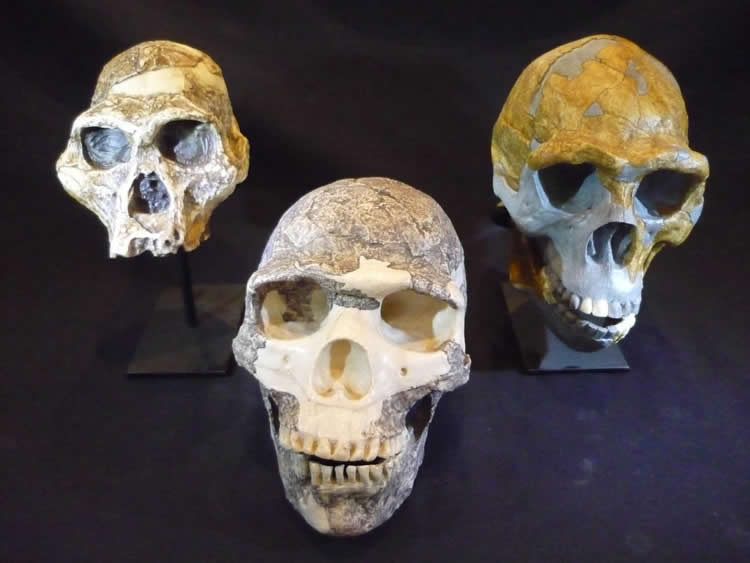Summary: An increase in blood supply appears to be linked closely to the evolution of human intelligence, a new study reports.
Source: University of Witwatersrand
In a new research collaboration between the University of Witwatersrand and the University of Adelaide, previously held views on the evolutionary development of the human brain are being challenged. The findings of their studies, published today in the Royal Society Open Science*, unseats previous theories that the progression of human intelligence is simply related to the increase in size of the brain.
Their research found that while brain size has increased by about 350% over human evolution, blood flow to the brain increased by an amazing 600%. The increase in the supply of blood to the brain appears to be closely linked to the evolution of human intelligence where the human brain has evolved to become not only larger, but more energetically costly and blood thirsty than previously believed.
Wits Brain Function Research Group co-author Dr Edward Snelling says: “Ancient fossil skulls from Africa reveal holes where the arteries supplying the brain passed through. The size of these holes show how blood flow increased from 3 million year old Australopithecus to modern humans.”

Source: Lisa Rautenbach – University of Witwatersrand
Image Source: NeuroscienceNews.com image is credited to Roger Seymour.
Original Research: Full open access research for “Fossil skulls reveal that blood flow rate to the brain increased faster than brain volume during human evolution” by Roger S. Seymour, Vanya Bosiocic, and Edward P. Snelling in Royal Society Open Science. Published online August 1 2016 doi:10.1098/rsos.160305
[cbtabs][cbtab title=”MLA”]University of Witwatersrand “Bloodthirsty Brains: Study Challenges Evolutionary Development of the Human Brain.” NeuroscienceNews. NeuroscienceNews, 1 September 2016.
<https://neurosciencenews.com/brain-evolution-development-4940/>.[/cbtab][cbtab title=”APA”]University of Witwatersrand (2016, September 1). Bloodthirsty Brains: Study Challenges Evolutionary Development of the Human Brain. NeuroscienceNew. Retrieved September 1, 2016 from https://neurosciencenews.com/brain-evolution-development-4940/[/cbtab][cbtab title=”Chicago”]University of Witwatersrand “Bloodthirsty Brains: Study Challenges Evolutionary Development of the Human Brain.” https://neurosciencenews.com/brain-evolution-development-4940/ (accessed September 1, 2016).[/cbtab][/cbtabs]
Abstract
Fossil skulls reveal that blood flow rate to the brain increased faster than brain volume during human evolution
The evolution of human cognition has been inferred from anthropological discoveries and estimates of brain size from fossil skulls. A more direct measure of cognition would be cerebral metabolic rate, which is proportional to cerebral blood flow rate (perfusion). The hominin cerebrum is supplied almost exclusively by the internal carotid arteries. The sizes of the foramina that transmitted these vessels in life can be measured in hominin fossil skulls and used to calculate cerebral perfusion rate. Perfusion in 11 species of hominin ancestors, from Australopithecus to archaic Homo sapiens, increases disproportionately when scaled against brain volume (the allometric exponent is 1.41). The high exponent indicates an increase in the metabolic intensity of cerebral tissue in later Homo species, rather than remaining constant (1.0) as expected by a linear increase in neuron number, or decreasing according to Kleiber’s Law (0.75). During 3 Myr of hominin evolution, cerebral tissue perfusion increased 1.7-fold, which, when multiplied by a 3.5-fold increase in brain size, indicates a 6.0-fold increase in total cerebral blood flow rate. This is probably associated with increased interneuron connectivity, synaptic activity and cognitive function, which all ultimately depend on cerebral metabolic rate.
“Fossil skulls reveal that blood flow rate to the brain increased faster than brain volume during human evolution” by Roger S. Seymour, Vanya Bosiocic, and Edward P. Snelling in Royal Society Open Science. Published online August 1 2016 doi:10.1098/rsos.160305






